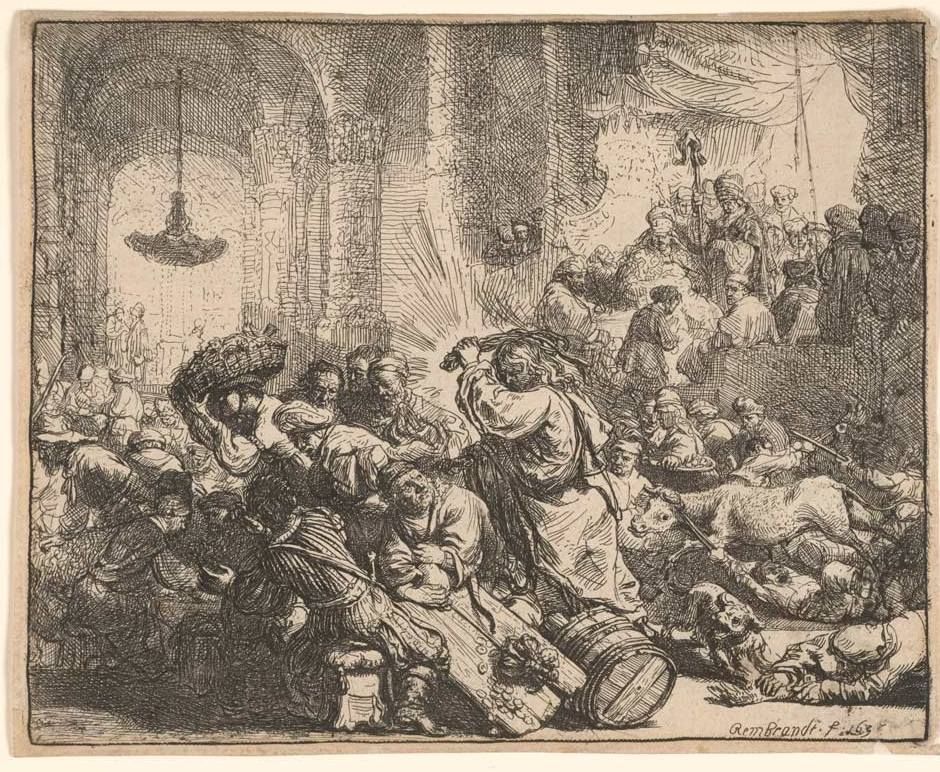The gold weigher by William Baillie
Download

after Rembrandt van Rijn (Dutch, 1606–1669)
Jan Uytenbogaert, ‘The gold weigher’, 1639
etching, drypoint
24.6 × 19.8 cm (plate)
25.4 × 20.6 cm (sheet)
Gift of Dr J. Orde Poynton, 1959
Baillieu Library Print Collection
University of Melbourne
1959.2195

Baillieu Library Print Collection, University of Melbourne
Jan Uytenbogaert was the Dutch receiver-general or tax collector. It is likely that Rembrandt knew Uytenbogaert, who helped the artist secure payments for his art and also to buy his house. Here he is depicted entering payments into his ledger as he hands a bag of gold to his assistant. In the background two people are waiting to have their gold weighed on the scales. Rembrandt was working during a time of flourishing trade and expanding colonial possessions, fuelled by unrivalled sea power; it was the Dutch golden age.
Rembrandt’s prints represent themes of finance and economics, and can serve as a study in market forces and manipulation. For example, Rembrandt deliberately manipulated supply in order to artificially inflate the price of his prints. Some of them were selectively printed in very few impressions, or he bought them back to re-sell for high prices on the secondary market to collectors seeking out his work. Other enterprising artists – like William Baillie – made money by reproducing Rembrandt’s most famous prints.
Dr J. Orde Poynton AO CMG (1906–2001), who in 1959 donated the core of the Baillieu Library Print Collection to the University of Melbourne, was a medical doctor, but had been a student of John Maynard Keynes (1883–1946), who helped found modern macroeconomics. Poynton made his wealth through shrewd investments, which enabled him to amass his striking collection of prints and books.
Teaching ideas
The University of Melbourne’s curriculum is rich and varied, and changes from year to year. For more teaching ideas, contact a collection manager.
Art History: Theory and Controversy
Focus on the art of the Dutch golden age by viewing examples, including Rembrandt, from the Baillieu Library Print Collection, to understand the historical and aesthetic characteristics of this artistic period.
Art, Market and Methods
Select Rembrandt or another high-profile artist from the Baillieu Library Print Collection to examine the changing status of the artist, the determination of authenticity and value, and the role of materials and markets in constructing meaning.
History of Economic Thought
Examine the collection of Dr J. Orde Poynton and discuss to what extent the economic theories and principles of John Maynard Keynes are represented.
Introductory Microeconomics
Explain the concepts of demand, supply, and market equilibrium. Using the sale of Rembrandt’s works of art as a case study, apply the model of demand and supply in a market to explain the determinants of prices and output of goods and services.
Consumerism and the Growth Economy
Using pictorial examples from the Baillieu Library Print Collection, analyse issues of sociology, psychology, ecology, normative ethics, economics and politics, to critically engage with questions about why people consume.
Financial Crises: A Critical Analysis
Identify pictorial examples in the Baillieu Library Print Collection to explain the background to, progression of, and resolution to, a financial crisis, such as the Dutch Tulip Bubble and the South Sea Bubble.
World Economic History
Explore the development of economic activity and material wellbeing in the world, primarily in the past 200 years, as it applies to the print market, printing of banknotes, and depictions of finance and economics.
Statistics
Choose an artist, such as Rembrandt, to examine art market indices and carry out standard statistical procedures using a statistical computing package.
Intersecting Objects
-

Rembrandt van Rijn (Dutch, 1606–1669)
The hundred guilder print (c. 1649)
etching, drypoint, engraving
27.9 × 38.7 cm (sheet trimmed to image)
Gift of Dr J. Orde Poynton, 1959
Baillieu Library Print Collection
University of Melbourne
1959.3755 -

Rembrandt van Rijn (Dutch, 1606–1669)
Christ driving the money changers from the temple, 1635
etching
13.5 × 16.7 cm (image)
14.0 × 17.3 cm (sheet)
Gift of Dr J. Orde Poynton, 1959
Baillieu Library Print
Collection University of Melbourne
1959.3704
To learn more, visit the website of the Baillieu Library Print Collection.
Further reading
Paul Crenshaw, Rembrandt’s bankruptcy: The artist, his patrons, and the art market in seventeenth-century Netherlands, New York: Cambridge University Press, 2006.
Erik Hinterding, Rembrandt, the printmaker, London: British Museum, 2000.